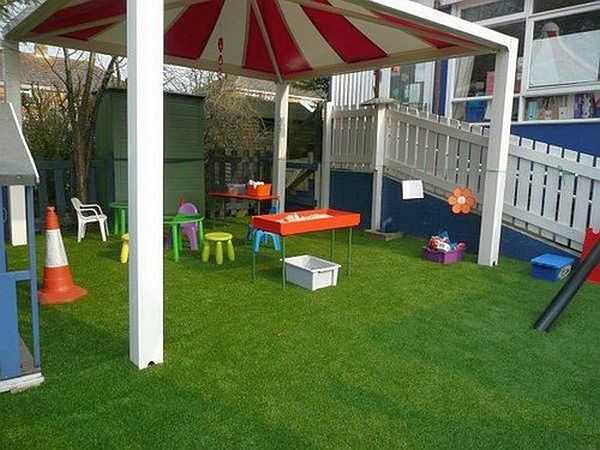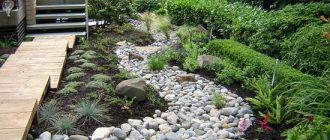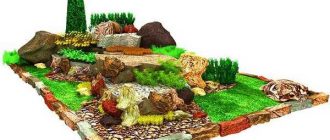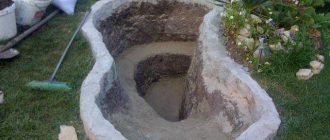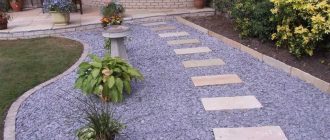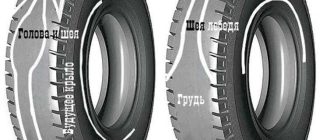A beautiful, well-maintained lawn near the house – this picture pleases not only the eye. Emerald grass emphasizes architectural solutions, highlights flowerbeds, rambatas, alpine slides. To make a lawn with your own hands you do not need much time, but to know how to do it correctly is necessary.
The basis of almost all lawns is grass. It is of different kinds, with different characteristics, different colors. In the climate of the middle zone of Russia feel well not all of them. Therefore, if you are going to buy a ready-made mixture, pay attention to the zoning: in the first wintering you risk losing the entire lawn.
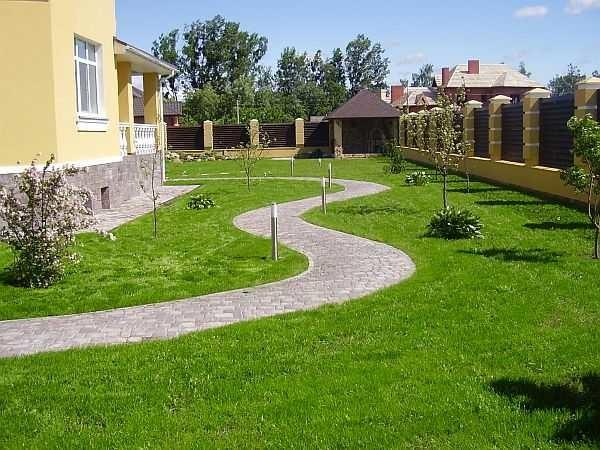
Be especially careful with ryegrass. It sprouts quickly, creates a thick and beautiful carpet, but does not tolerate frosts well and freezes in our climate. When buying a ready-made grass mixture, look at its composition: there should be a little ryegrass. Even if it freezes, it will not do much harm.
Conteúdo do artigo
When to sow grass
You can sow grass from May 1 to August 15. When sowing in the spring, increase the amount of seeds per square meter slightly (by 10-15%). This way you will get a beautiful lawn faster and the lawn will be stronger in winter. Because of the high density, the plants will start to compete with each other and the weaker ones will be forced out. Only the strong ones will survive until fall.
When sowing in the summer, stick to the seed rate. Due to the lack of time, the weak plants will not be displaced in time, but all will be weakened by this competition. That is why good care is important for summer lawns.
Which lawn grass is the best
Fescue and bluegrass are the most beautifully colored and dense grass. Their greens are delicate and emerald. They are used to create a parthen lawn. But for other types of lawns that will be walked on, they cannot be used: they will quickly become trampled. On such lawns, it is more common to sow different varieties of volesia. Not so delicate, it tolerates a certain degree of strain well.

Fescue is also more suitable for shady lawns. But even it will not grow in deep and permanent shade. Salt light is the basis of photosynthesis. And at least some of the time the lawn must be illuminated.
Types of lawns
We are accustomed to the fact that the lawn is necessarily grass, covering the soil. In it can be arranged flowerbeds, rabatas, alpine slides and other decorative elements. This is not entirely true. There are at least three other varieties of flowering lawns. They are undoubtedly more decorative, but you can hardly walk on them.
Flowering lawns
They are based on grasses, but significantly “diluted” with perennial or annual flowering plants. They are selected so that they bloom throughout the entire growing season – from mid-spring to late fall. Depending on which plants are included, three types of flowering lawns are distinguished.
Meadow
Already by the name it is clear that in the composition of plants that can be seen in a real meadow. Only rarely in full composition and in a strictly measured proportion. To the cereals are added such traditional inhabitants of the meadow, such as clover, chamomile, daisy, montane verbey, yarrow and other flowering or ornamental-leaved plants. Despite the abundance of flowers the main ones are grasses.
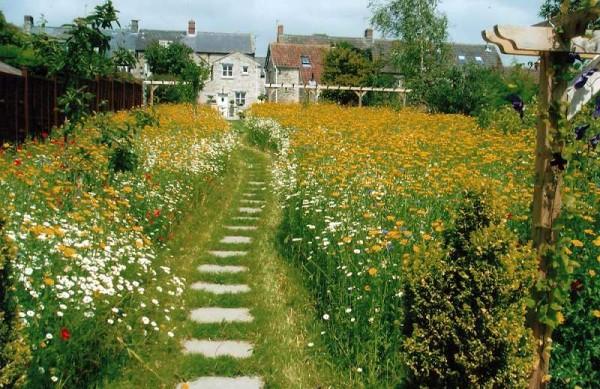
It is clear that mow often such beauty will not be, but once or twice a season for renewal and rejuvenation have to cut. Plants are perennial, so with proper watering quickly restore decorativeness. To sow the entire territory with such a mixture is not always appropriate, but some areas are very pleasing to the eye.
Moorish
It differs in that the flowers used are annual. Therefore, such a lawn is not cut at all. Grasses are selected low-growing, there are fewer of them than flowers. Flowers dominate the Moorish lawn. Both in height and quantity (look at the photo).
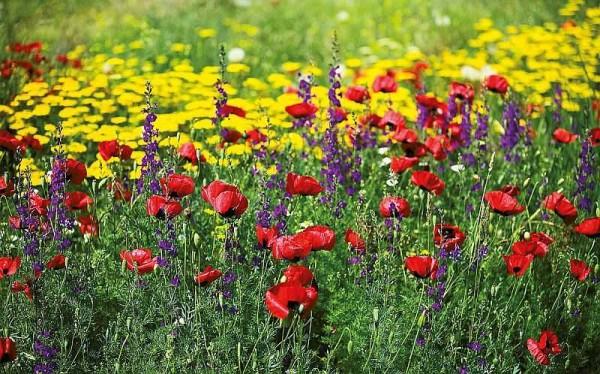
They are selected so that the flowering was as long as possible. Usually in the composition of poppies, cornflower, calendula, matiola, large-colored flax, eschscholzia and other bright annuals.
Non-grass
This is a completely unfamiliar lawn composition, consisting of ground cover plants. To sow them in the open ground – a futile business, to grow seedlings – long, and buy ready-made – expensive. Therefore, non-grass lawn grow not one year and not two: plant plants in small quantities, waiting for them to grow. This lawn with your own hands to grow the most difficult: the results of labor are visible only after a few years, but the effort is worth it.

Grass lawns
To a layman’s eye, the different types of grass lawns are almost identical: the color may be slightly different. But apart from the different shades of green, they have different characteristics: some can be walked on, others are contraindicated, different sowing rates and different care is required. Naturally, different grasses with different characteristics are used.
Common
The most resistant to trampling, you can walk on it. Grasses are selected with stiff, rough-looking grasses. But it is easier to care for it, weeding less often, some blunders, which are often made when self-sowing, are not visible. Ordinary lawn – an excellent choice for dacha.
Parterre
This is one of the most decorative and parade lawns. It is distinguished by high decorativeness, grasses are selected delicate, beautiful colors. Grass is low and dense, with proper care looks simply gorgeous. Such lawns are arranged in open places, but where no one will walk: too soft grasses will not withstand such a load. This is why parterre lawns (see photo) are sown where people walk only on paths.
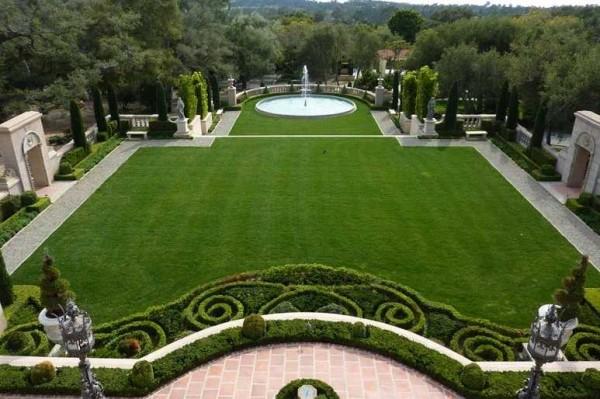
Special
It is planted on slopes. As part of his grasses, which have an extensive root system, capable of keeping the soil from washing out. The decorative value of such a covering is average, but it fulfills its main purpose well. Special lawns can be planted on a slope leading to a river or lake, if there is one on your plot.
Sports
The mixture is more complex – in addition to the traditional varieties of grasses are special, more resistant to abrasion. Decorativeness of the sports lawn is not its main characteristic, so even a very well-maintained lawn looks much worse than an ordinary lawn, and even more so than a parterre lawn. But it has a very high resistance to abrasion.
Because of the use of special grasses, its cost is higher, more difficult to care for. That’s why it is necessary to sow with such a mixture those areas that will be actively used: the area for games, the area where they will actively walk – near the gazebo, sports ground, swings. The rest of the area is often allocated for ordinary lawns.
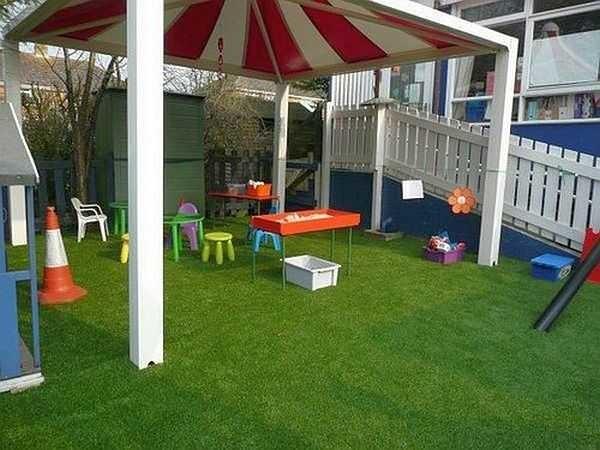
Natural
For this type of coating do not buy mixtures, do not carry out any work. Simply cut those grasses that are available. Most often natural lawn is left in the garden: it protects the soil well from drying out, and the requirements for decorativeness are not very high here. Too large plants that do not fit into the desired picture are removed manually. The rest in the process of mowing become finer and finer, forming turf of different colors.
How to make a beautiful lawn
Growing a lawn consists of several stages:
- Preparing the soil – removing weeds, if necessary – correcting acidity and increasing fertility.
- Sowing grass, regular watering.
- First mowing. It is carried out after the grass has reached a certain size.
- Regular maintenance and periodic mowing.
In the process, you will have to monitor the moisture content of the soil and remove weeds in a timely manner, from time to time to conduct fertilizing, sow the gaps that may appear after an overly dry summer or too harsh winter. This is, in brief, the whole technology of growing a lawn, and then detailed point by point.
Preparing the soil
The first thing to do is to assess the fertility of the soil. If the soil is clay or loam, grass will not grow normally on it. You will have to carry out serious soil preparation. There are two options: to fill the site from above with fertile soil or to remove the soil and in the resulting pit pour the earth.
It is easier, of course, to just fill in the soil, but this is not always possible: the soil layer in this case should be about 20 cm. Raising the lawn to such a height is not the most sensible solution: there will be problems with water drainage, high well-strengthened curbs are required, and the appearance is strange. Therefore, more often remove clay soils to a depth of 15-20 cm, and then in the resulting trench bring the earth.
If you choose the second option, at the bottom of the excavation can be laid geotextile. It will not let weeds grow through it, and you will have no problems with weeding.
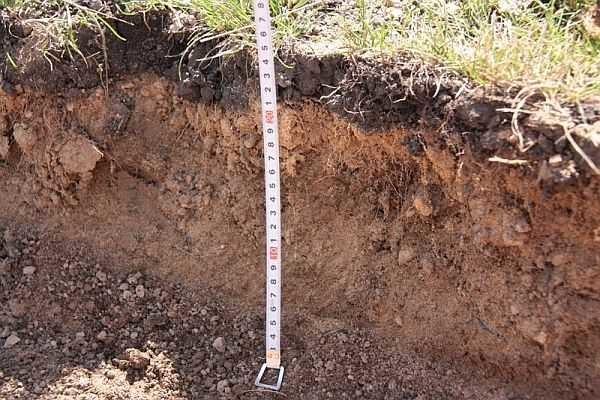
If the soil is normal, preparing the soil for lawn grass is not so difficult. First remove all weeds. This can be done mechanically – with a hoe and/or hands, you can use herbicides. They are diluted according to the instructions, water the place of the future lawn. After a few days, the vegetation turns yellow and dries up, it is removed. Simultaneously with the release from weeds, remove stones, roots, other fragments that can interfere with the growth of the terminal system.
The next stage is to check the acidity of the soil. Almost all grasses included in lawn mixtures grow well on neutral soils. If you want to have a beautiful lawn, you will have to correct its acidity. Therefore, in the store for gardeners and gardeners find a set for determining the acidity of the soil and check what kind of soil on your plot. It is just litmus paper, which should be placed on the soil, wait until it turns color and determine the acidity of your soil according to the color chart on the package. If the soil is acidic, add lime, if the reaction is alkaline – scatter crushed peat. Next comes the digging. Simultaneously with loosening remove those stones and roots that will get caught.
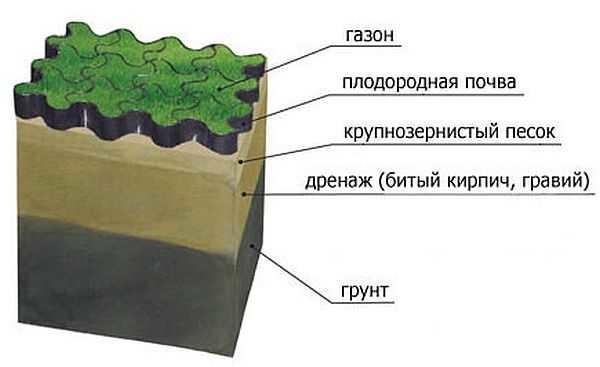
The next step is to add a fertile layer. Fertile, loose and light soil is brought in and distributed over the entire plot in an even layer 6-10 cm thick. The layer is leveled first with shovels, then with rakes. It is desirable to form a slight slope towards the fence: this way you will not have problems with overwatering the lawn in heavy rain: the water will run off the plot. The slope is minimal – 1 cm per meter or meter and a half. This is enough to ensure that the water drains away, and it will not be noticeable from the outside.
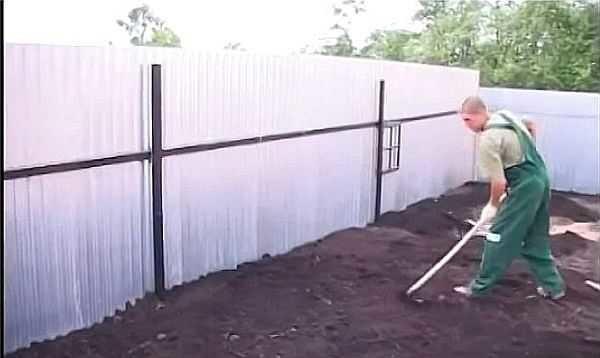
One tip: imported soil contains roots, stones, branches, etc. To remove them, it is sifted through a coarse mesh (as is done in construction when sifting sand). And the sifted is already distributed around the site.
The next step in the arrangement of the lawn with your own hands – tamping or rolling. It allows you to compact the soil, and when a person steps on the lawn, the soil under the foot is not crushed, and remains even. Also this process allows you to identify irregularities that are bound to appear as a result of all land works.
If there is no special roller, it can be made from a piece of asbestos or iron pipe. Inside the pipe you thread a rod, to it you cling the handles (even just rope tied). All the roller for the lawn with your own hands you have made. Now it is dragged around the site, tamping the soil until it can stand on it without falling through.
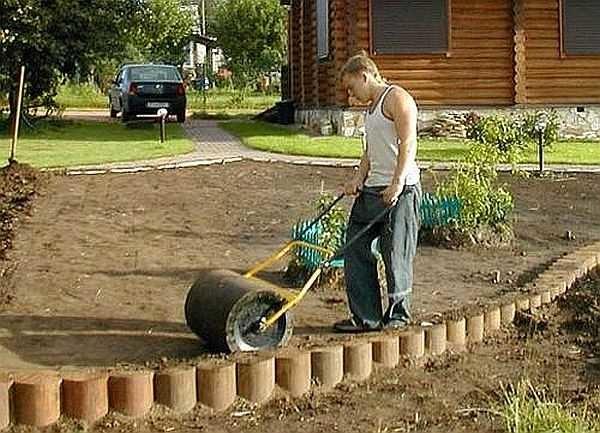
Rolling the lawn will definitely reveal humps and pits. Remove the excess from the humps, fill the holes. Having leveled the surface in this way, take a lawn roller and once again pass the area. To get a perfectly even surface, you can take a long board and pull it through two along the site, cutting off the edges of irregularities. Or make a device of two boards – as in the photo below. You can work with it alone.
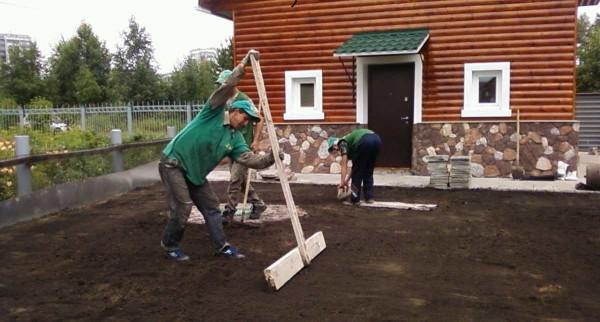
Fertilizing
Fertilizer can be applied at several stages (one of them). In principle, if you pour 6-10 cm of imported soil on top of the normal soil, fertilizers can not be used. But for more active growth – you can add:
- after scattering the imported soil on the plot and before leveling with a rake;
- if dry fertilizers are used, they can be mixed with seeds;
- spread and water the soil.
The most optimal method is watering. He guarantees a more even distribution of nutrients. But with this method, rarely anyone wants to bother, unless there is an automatic watering system. The other two are equivalent. It is more convenient to apply together with seeds: it takes less time.
Planting grass
Beforehand it is necessary to rake a little loosen the tamped earth. Just go through with a light rake, slightly loosening the top layer. Now you can sow the grass.
Buy a seeder, which costs about 200-300$ for a single application is hardly reasonable, so pour the seeds for the lawn in a bucket, and the old grandfather’s method of scattering on the surface: take a handful and passing a little through your fingers, scatter more or less evenly. Those who want at least some mechanization, you can offer two options for the simplest seeders for lawn grass, which are easy to make with their own hands. This is a tin or plastic bottle, in which holes are made (see photo).
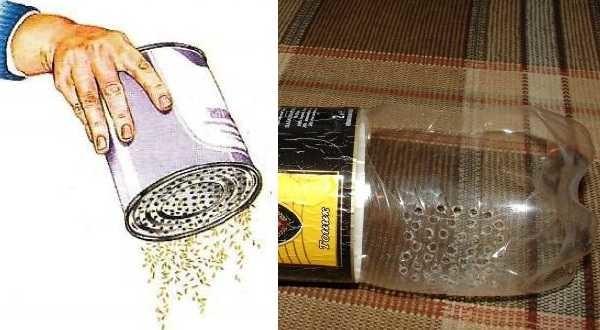
So that it does not turn out that in one corner is dense, and in the other – empty, it is desirable to divide the plot and seeds into parts. The seed consumption is specified for each mixture. What is the area of the sown area, you can estimate on the spot and measure the amount that needs to be scattered. For those who make a lawn at home with their own hands for the first time, it is better to divide the measured amount into two equal parts and pass the site first along, and then across. So the seeds will be distributed more evenly.
After sowing, the seeds need to be covered with earth. There are two ways to do this:
- Walk the site with a rake, trying to cover the seeds with earth. This method is less reliable – many remain outside, they are pecked by birds, and the germination deteriorates.
- Sprinkle the rest of the imported earth on top. The layer is 3-5 mm. All seeds are covered with earth, are in the best conditions, germination is better.
At this point you can consider that the lawn with your own hands you have made. It remains to water and wait for the sprouts.
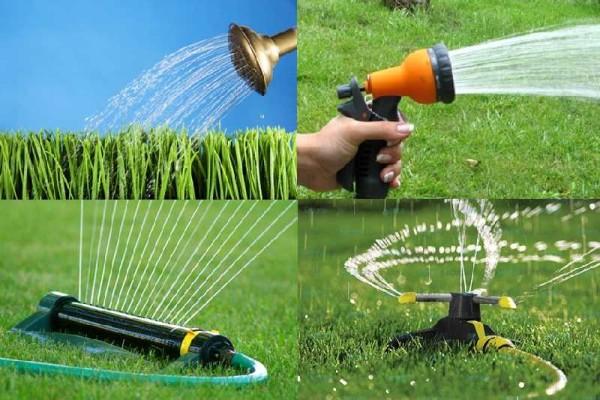
Watering and waiting
Water the lawn depending on the conditions: the soil should not dry out, but it should not be very wet either. The water should not come in large streams, there should be no streams or puddles. The stream is broken into small streams: install a sprinkler or sprinkler, if you water by hand, on the hose put on a nozzle. In the photo above you will see several options that will help solve the problem of watering. They are sold in stores.
There are also a few homemade options for lawn sprinklers. In most of them, it is a plastic bottle with holes made in it, connected to a watering hose. It can lay down and irrigate an adjacent area. If there is enough pressure in the system, you can tie it to a pole. In this case, the watering area will be larger. Sprinklers for watering the lawn with their own hands to make very simple. Look at the photo.

Another way to get small splashes: in a piece of plastic pipe make holes or make a thin kerf. You get either thin jets or a fan (bottom right photo).
Why should water be sprayed? Because for the normal development of the root system, the soil must be moist (but not wet) to a depth of about 6-10 cm. If it is just poured on top, it will only make things worse: the water displaces oxygen and the roots have nothing to breathe. So sprinkling or drip irrigation is the best way to water the lawn.
After seven to ten days, the first seedlings appear. They are still sparse, but don’t be disheartened. Only the seeds of some varieties, which germinate quickly, have sprouted. The others germinate later. With proper care after 20-30 days, the height of the grass stand reaches 10-15 cm. At this time it is necessary to carry out the first mowing. You leave about 5 cm of height for the first time. At this height, the grass will grow actively. After another 10-12 days, it will again be about 12 cm high. Now you can cut the grass shorter – leaving 3-3,5 cm.
How to care for the lawn grass
The main care is timely watering, weed removal and periodic mowing. If you water by sprinkling, there will be enough oxygen in the soil and the plants should develop normally.

Problems with a lack of oxygen can occur after long heavy rains, when the water stands in puddles on the plot or when watering incorrectly with the same result. Lawn aeration is then necessary. For this purpose, a roller is used, similar to the one used when tamping the soil, but this one has points that pierce the turf. Through these punctures oxygen enters the soil and the plants start to grow better.

